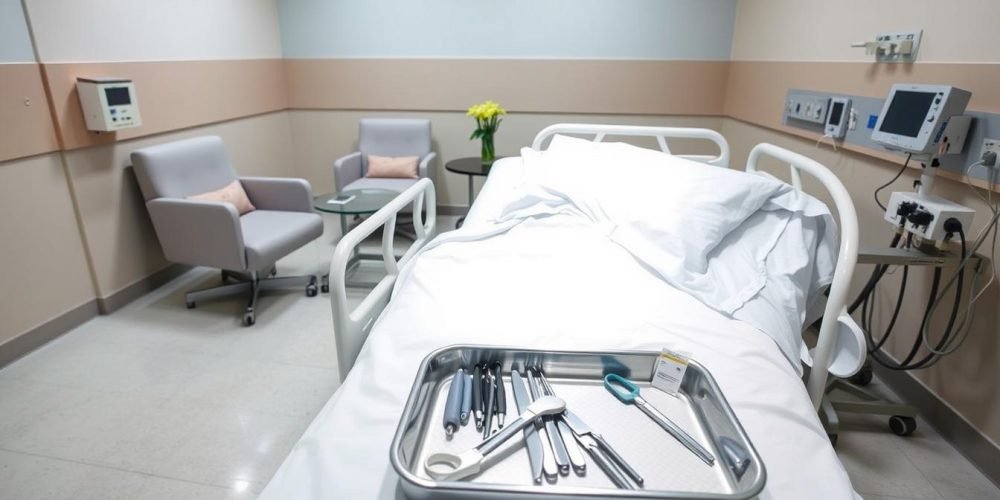C-section : As you get ready for your baby’s arrival, knowing about C-section preparation is key. This surgical method is often chosen for health reasons. It might seem scary, but knowing what to expect can make it easier.
In this article, we’ll share important C-section tips and insights. We aim to help you feel more prepared for motherhood. With the right information, you can feel less anxious and more confident about your C-section.
Key Takeaways
- Being informed about the C-section procedure increases confidence.
- Understanding the reasons for choosing a C-section can ease concerns.
- Mental preparation is just as important as physical preparation.
- Pack your hospital bag with essential items ahead of time.
- Post-operative care is key to a smooth recovery process.
- Emotional support during recovery is vital to well-being.
Understanding the C-section Procedure
The C-section procedure, or Cesarean delivery, is a surgical way to deliver a baby. It involves making incisions in the mother’s abdomen and uterus. This method is chosen when vaginal delivery is risky for the mother or baby.
First, the patient gets ready for surgery in a clean environment. They might get regional anesthesia, like an epidural, or general anesthesia. The type of anesthesia affects how the patient feels during the surgery.
The surgical team includes an obstetrician, nurses, and an anesthesiologist. The obstetrician makes a horizontal incision in the lower abdomen. Sometimes, a vertical incision is needed. The baby is then delivered, and the placenta is removed.
After the baby is born, the incisions are closed with sutures. It’s important to monitor the mother and baby closely after surgery. Knowing about these steps can help patients feel more prepared for their Cesarean delivery.
Reasons for Choosing a C-section
Many women face the decision of whether to have a C-section. This choice is influenced by various reasons for C-section. It can be due to elective reasons or medical necessity. It’s important for expectant mothers and their families to understand these motivations.
An elective C-section might be chosen for personal reasons or convenience. Some mothers prefer it for more control over when they give birth. Others like the predictability of a scheduled delivery. However, medical necessity also plays a role. Healthcare providers may recommend a C-section if there’s fetal distress, pre-existing health issues, or complications during labor.
When deciding on a C-section, it’s key for the mother and her healthcare provider to talk thoroughly. This conversation helps clarify the reasons for a C-section and addresses any concerns. Knowing the medical implications and options available helps make informed choices. These choices prioritize the health and well-being of both the mother and her child.
| Type of C-section | Description | Typical Reasons |
|---|---|---|
| Elective C-section | Planned surgical delivery chosen by the mother. | Preference for scheduled delivery, anxiety about labor, previous delivery experiences. |
| Medically Necessary C-section | Surgical delivery required due to complications. | Fetal distress, health issues in mother, labor complications. |
Preparing Mentally for Your C-section
Having a C-section can bring up many emotions. It’s key to mentally prepare for it. Expectant mothers often worry about surgery complications, pain, and recovery challenges. Talking openly with healthcare professionals can help ease these worries and give a sense of control.
Addressing Common Fears and Concerns
It’s normal to feel scared before a C-section. Common fears include:
- Potential complications associated with surgery
- Pain management strategies
- The recovery process and timeline
To face these fears, getting informed is important. Knowing about the procedure can boost confidence. Support groups and online resources offer comfort and understanding.
Importance of Support Systems
A strong support network is crucial for the postpartum journey. Support from partners, family, and friends can reduce anxiety and help with recovery. The benefits include:
- Emotional reassurance during tough times
- Help with daily tasks to lower stress
- A place to share feelings and thoughts
Building this network early ensures new moms don’t feel alone. Talking openly about feelings and needs helps create a supportive healing environment.
| Fear or Concern | Potential Solution |
|---|---|
| Surgery complications | Discuss with healthcare providers and understand the risks and benefits |
| Pain management | Inquire about pain relief options before and after the procedure |
| Recovery challenges | Create a postpartum plan with support from family and friends |
Physical Preparations for a C-section
Getting ready for a C-section is key to a smooth recovery. Good nutrition and exercise are crucial. They help you heal faster and feel stronger after surgery.
Nutrition and Hydration Tips
Eating right is vital after a C-section. A diet full of vitamins and minerals helps your body heal. Make sure to eat a variety of foods:
- Fruits and Vegetables: Pick colorful ones for more nutrients.
- Whole Grains: Brown rice, quinoa, and whole-grain bread give you energy.
- Lean Proteins: Chicken, fish, beans, and legumes help repair tissues.
- Dairy: Milk, yogurt, and cheese are good for bones.
- Healthy Fats: Avocados and nuts reduce inflammation.
Drinking plenty of water is also key. It helps with circulation and digestion. Staying hydrated speeds up recovery.
Building a Pre-op Exercise Routine
Exercising before surgery keeps you fit and ready. Choose safe, low-impact activities. Here are some good ones:
- Walking: It’s great for your heart and keeps you moving.
- Yoga: It improves flexibility and reduces stress.
- Pelvic Floor Exercises: These strengthen muscles and help with bladder control.

What to Expect on the Day of Your C-section
Knowing what to expect on C-section day can help you feel more at ease. The day starts early, so getting to the hospital on time is key. Always follow your doctor’s advice on eating or drinking before you go.
When you arrive, you’ll go through several checks. They’ll look at your medical history, confirm the C-section plan, and check your vital signs. An IV line will be put in to give you fluids and medicine during the surgery.
Before the surgery, you might have more tests to make sure everything is ready. You’ll see monitors attached to track your baby’s heart rate and your vital signs. These steps help your medical team keep you and your baby safe during the surgery.
How to Pack Your Hospital Bag
Getting ready for a C-section can feel like a big task. But with a good plan, you can make sure you have everything you need. Pack items that are both comfortable and convenient for you and your baby. A well-organized list makes it easy to find what you need in the hospital.
Essential Items for Mom
- Comfortable Clothing: Pick loose-fitting pajamas or a robe for easy access during recovery.
- Hygiene Products: Remember to pack a toothbrush, toothpaste, shampoo, conditioner, and skincare products.
- Personal Items: Bring eyeglasses, chargers for devices, and a comfy pillow.
- Snacks and Drinks: Pack light snacks like granola bars for your hospital stay.
- Medication: Bring any prescriptions and talk about pain management with your doctor.
Preparing for Baby’s Arrival
- Clothing: Pack several outfits for your baby, with easy-to-change designs.
- Diapers and Wipes: Include enough for the first days after birth.
- Swaddling Blankets: These offer comfort and warmth for your newborn.
- Car Seat: Make sure it’s installed in your vehicle before going to the hospital.
Post-Operative Care After Your C-section
After a C-section, it’s key to take good care of yourself. This means managing pain and looking after the surgical area. Knowing how to do this can make your healing time more comfortable.
Managing Pain and Discomfort
Managing pain is a big part of getting better after a C-section. Doctors usually give you medicine to help with pain. It’s important to take it as told to stay comfortable and heal well.
- Medications: Stick to the pain meds your doctor gave you.
- Relaxation Techniques: Try deep breathing or meditation to help with pain.
- Gradual Movement: Move a little as your doctor says to help with healing.
Wound Care and Recovery Tips
Looking after your wound is key to avoid infections and heal well. Watch the incision site for any signs of trouble.
- Cleaning: Keep the incision clean and dry. Use mild soap and water as told.
- Signs of Infection: Watch for redness, swelling, or discharge. Call your doctor right away if you see these.
- Recovery Guidelines: Do what your doctor says about how active you can be.
Talking closely with your healthcare team is important during this time. Being proactive about your symptoms and following their advice will help you heal better.
| Care Tip | Description |
|---|---|
| Medication Management | Take your pain meds as scheduled for best results. |
| Wound Observation | Watch the incision for any odd changes and tell your doctor. |
| Activity Level | Start moving more as your doctor advises. |
| Support System | Use friends and family for emotional and physical support. |
Emotional Recovery After a C-section
The emotional recovery after a C-section is key to a mother’s healing. This time brings joy from welcoming a new life. But it also brings sadness and anxiety from postpartum emotions. It’s important to know these feelings are normal and can differ for everyone.
Understanding these emotions shows why mental health support is crucial during this time.
Understanding Postpartum Emotions
Postpartum emotions can be intense. Many mothers feel a mix of happiness and sadness. Recognizing these feelings is helpful.
Knowing when feelings are more than usual can signal a need for support. Signs of postpartum depression should not be ignored.
Seeking Help When Needed
Support from loved ones and professionals is vital for emotional recovery. If feelings like hopelessness or sadness last too long, seeking help is key. Counseling and support groups offer safe spaces to talk about feelings.
Connecting with others can help understand and recover from these experiences.
Incorporating Family During Recovery
Family support is key after a C-section. It helps new moms feel cared for and supported. When family helps out, it makes the recovery process easier and more loving.
To involve family, start by giving them tasks like cooking and cleaning. This lets the mom rest and recover. It’s also important to set clear boundaries so she can rest while still being with loved ones. Talking openly about what she needs helps family members know how to help best.
Assigning roles to family members makes everyone feel involved and united. For example, one person can watch the older kids, while another does errands. This not only helps the mom but also fills the home with love and support.
But it’s not just about the physical help. Emotional support is just as important. When family members offer encouragement and understanding, it helps fight off feelings of loneliness and doubt. By doing this, we create a space that helps everyone heal and feel better.
Guidance for a Smooth C-section Experience
Getting ready for a smooth C-section starts well before the surgery. Talking openly with your healthcare team is key. Share your likes and worries to get a plan that fits you.
Having a birthing plan, even for a C-section, helps a lot. It lists what’s important to you, like who to have with you in the OR. It also covers things like skin-to-skin contact right after birth. This makes your C-section more likely to go well.
- Consult with your doctor to address all questions regarding the procedure.
- Practice relaxation techniques, so you feel calm on the day of your C-section.
- Engage a support person to accompany you through various stages of this experience.

Building trust with your medical team helps reduce stress. Feeling secure about your care makes your surgery better. Make sure everything is ready for your C-section and go into it with confidence.
| Aspect | Importance | Surgical Birth Tips |
|---|---|---|
| Communication | Builds trust and ensures everyone’s on the same page | Ask detailed questions before surgery |
| Birthing Plan | Clarifies expectations and preferences | Include specific requests regarding care after birth |
| Support System | Offers emotional support during the procedure | Choose someone who understands your wishes |
Preparing for Future Pregnancies Post-C-section
Planning for future pregnancies after a C-section needs careful thought. Doctors often suggest waiting a certain time before trying again. This wait helps the body heal and lowers the risk of problems in future pregnancies.
Here are important things to think about when planning your family after a C-section:
- Recommended Waiting Period: A wait of 18 to 24 months is usually suggested. This time helps avoid risks like uterine rupture and other issues.
- Understanding Risks: Pregnancies after a C-section might face risks like placenta previa or scarring. It’s crucial to talk about these with your doctor to plan well.
- Preconception Counseling: Preconception counseling gives insights into being ready physically and emotionally for another pregnancy. It helps tailor health needs.
Your C-section recovery guide should also cover watching for symptoms or concerns before planning the next pregnancy.
| Considerations | Importance |
|---|---|
| Waiting Period | Ensures complete recovery and reduces risks |
| Health Monitoring | Identifies any issues that may affect future pregnancies |
| Nutritional Needs | Supports a healthy pregnancy and recovery |
Getting support from healthcare providers and discussing your situation helps a lot. A well-rounded approach prepares families for what’s next.
Conclusion
As we wrap up our talk on C-section preparation, it’s key to sum up the main points. Knowing the procedure, understanding your needs, and packing your bag are crucial. These steps help make your surgical birth experience better.
We’ve talked about how being proactive with your healthcare team can reduce stress. Getting ready emotionally and physically helps you recover faster. It also builds a strong support network, which is vital during this time.
Welcoming a new life involves many steps, and knowing them helps make the experience joyful. Every preparation step you take helps with recovery and makes the birth memorable. Approach this journey with confidence and support.




